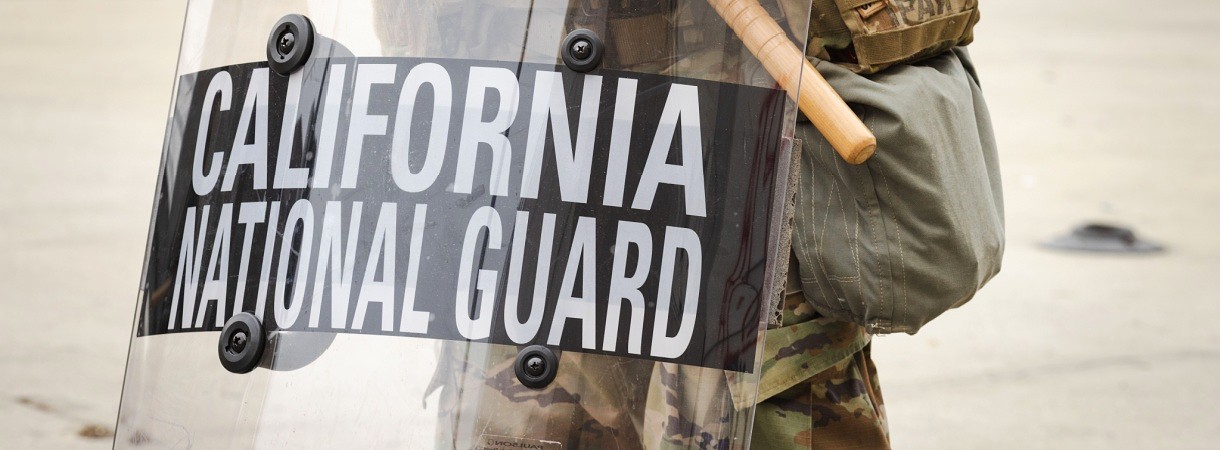Three months after the Trump administration first sent troops to Los Angeles, a federal judge ruled that their National Guard deployment was illegal. As President Trump considers extending the federal takeover of Washington D.C. and ordering troops to Chicago, Baltimore, Memphis, and New Orleans, LA residents are still recovering from the public safety, economic, and social impacts of this deployment – illustrating what may be in store for other major U.S. cities soon.
Why did Trump send troops to LA?
This spring, federal immigration enforcement in the LA region skyrocketed, with immigration arrests quadrupling between April and June. Immigrants without criminal convictions made up an increasing share of monthly arrests, jumping from 35 to 69% and challenging the Trump administration’s claims of targeting criminals for deportation. Evidence of racial profiling by federal immigration officers in LA initially resulted in a court order barring them from stopping someone based solely on race, language, job, or location, which the U.S. Supreme Court later overruled.
In early June, protests emerged in pockets of LA, following weeks of escalating immigration raids across the city, reports of inhumane detention conditions, and racial profiling concerns. Local officials, responding to isolated clashes between local law enforcement and some protestors, issued overnight curfews in downtown LA as they worked to lower tensions. Over objections from local and state leaders, President Trump then deployed 4,100 National Guard troops and 700 Marines to LA, ostensibly to protect federal personnel and property from protestors.
How did troops impact public safety?
By August, the Trump administration removed all but 250 troops from LA, claiming victory and restored public safety. The operation resulted in the U.S. Department of Justice (DOJ) charging just 26 individuals for crimes relating to protests over immigration raids. Notably, DOJ prosecutors dismissed eight of these charges shortly after filing, five because of false statements made by U.S. immigration officials. As the dust settles, it’s also clearer how this deployment posed its own threats to public safety, both during the protests and beyond.
From the start, state and local officials in California pushed back against the deployment as unnecessary and inflammatory. Even at the height of the protests, LA Police Department Chief Jim McDonnell insisted that, “We’re nowhere near a level where we would be reaching out to the governor for the National Guard.”
It marked the first time since the 1960s that the National Guard was deployed without a governor’s consent. Governor Gavin Newsom later sued the Trump administration, claiming in separate filings that the deployment unlawfully bypassed the governor’s permission and violated federal law by using troops for civilian law enforcement. Critics of the deployment emphasized it undermined public safety by escalating local tensions, diverting National Guard resources from critical work, including counterdrug operations, intimidating communities, and eroding public trust in the U.S. military.
Records disclosed in court unveiled that U.S. military leaders shared major concerns about this deployment and questioned whether troops were adequately trained for a domestic operation. They noted the operation could spur new protests, posing a significant risk to both LA residents and troops. National Guard members themselves also voiced concerns about being sent to LA with reports of decreased troop morale, amid a lack of work to do, and concerns over how the deployment could hurt military recruitment efforts for the next several years.
Who bears the costs of this deployment?
The U.S. Department of Defense initially estimated that the deployments would cost U.S. taxpayers at least $134 million. The operation’s exact costs remain undisclosed, with requests pending from California’s U.S. senators and governor to the federal government to get a more accurate picture of official expenses. In the meantime, Governor Newson’s office produced their own estimates, reporting $120 million in deployment costs so far.
This price tag for American taxpayers, however, is only a fraction of the full costs of the deployment.
In California, residents shoulder additional economic and social impacts, between the increase in immigration enforcement actions and the military deployment. Small businesses throughout LA are hurting from steep declines in foot traffic and sales. Employees weigh the risks of showing up to work, student attendance is in decline, and healthcare visits by immigrant patients have dropped off. The vibrancy of the city has become duller this summer, as communities are gripped by fear.
What comes next?
From the original 4,100 troops, now 250 National Guard troops remain in LA as the state’s lawsuit against the deployment continues. The Trump administration has appealed a federal judge’s finding that National Guard members were illegally used for civilian law enforcement. Locally, LA city and county officials are launching funds to help communities rebuild from raids and city leaders have established new school protection measures for immigrant families.
The turmoil caused by the increased federal presence in LA has upended life for many undocumented residents, mixed-status families, and U.S. citizens across the region. Now, other U.S. cities are striving to uphold the safety and well-being of their communities, as they brace for troops to be sent their way.
